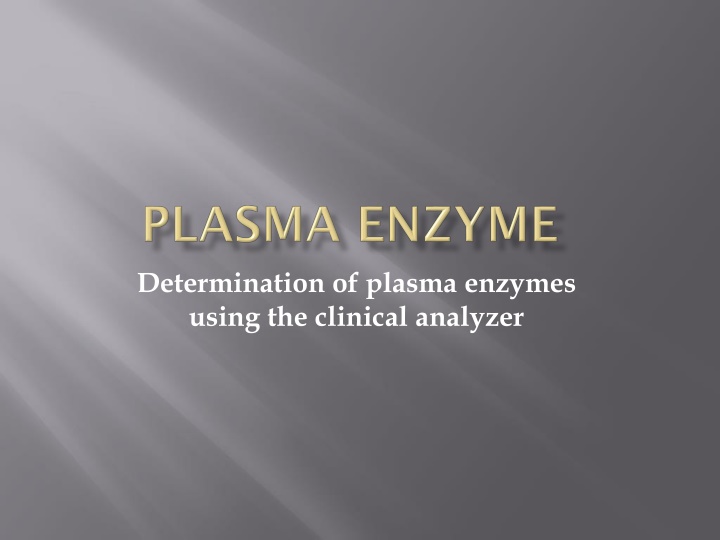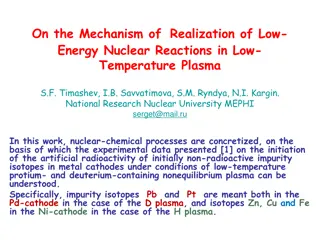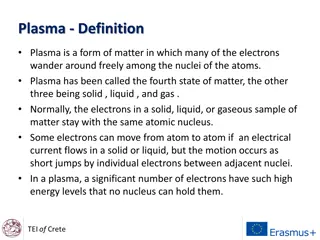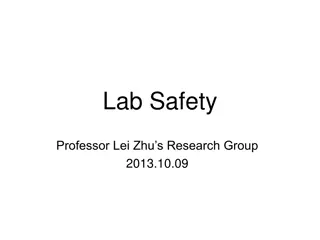
Plasma Enzymes and LDH Levels in Health
Learn about the classification of plasma enzymes, the significance of measuring non-functional enzymes, and the role of Lactic Acid Dehydrogenase (LDH) in assessing tissue damage. Explore how enzymes are released due to cell damage, the conversion of lactate by the liver, and the forms of LDH isoenzymes found in various tissues.
Download Presentation

Please find below an Image/Link to download the presentation.
The content on the website is provided AS IS for your information and personal use only. It may not be sold, licensed, or shared on other websites without obtaining consent from the author. If you encounter any issues during the download, it is possible that the publisher has removed the file from their server.
You are allowed to download the files provided on this website for personal or commercial use, subject to the condition that they are used lawfully. All files are the property of their respective owners.
The content on the website is provided AS IS for your information and personal use only. It may not be sold, licensed, or shared on other websites without obtaining consent from the author.
E N D
Presentation Transcript
Determination of plasma enzymes using the clinical analyzer
Blood plasma contains many enzymes which are classified into: 1. Functional plasma enzymes 2. Non functional plasma enzyme
Cell damage with the release of its content of enzymes into blood e.g. Myocardial infarction and viral hepatitis Obstruction of normal pathways e.g. Obstruction of bile duct increases alkaline phosphatase Increase of the enzyme synthesis e.g. bilirubin increases the rate of synthesis of alkaline phosphatase in obstructive liver disease Increased permeability of cell membrane as in hypoxia
Measurement of non functional enzymes is important for: Diagnosis of diseases Prognosis of the disease
* Lactic acid dehydrogenase (LDH) is an enzyme that helps produce energy * Normal LDH levels range from 45 U/L to 90 U/L. * LDH is most often measured to evaluate the presence of tissue damage.(diagnostic ) * The enzyme LDH is in many body tissues, especially the heart, liver, kidney, skeletal muscle, brain, blood cells, and lungs..
Lactate is released into the blood and is eventually taken up by the liver. The liver converts lactate back to glucose and releases glucose into the blood. This glucose is then taken up by resting muscles, red blood cells, and other Tissue
*Exercising muscles convert (and red blood cells metabolize) glucose to lactate. *The optimum pH for lactate pyruvate (L reaction is 8.8 9.8 *while for pyruvate to lactate (P * The enzyme is inhibited by sulfhydryl reagents such as P-chloromercuribenzoate and mercuric ions. P) L) is 7.7 7.8. 8
LDH exists in 5 forms (isoenzymes), which differ slightly in structure. LDH Enzyme Level U/G Tissues Isoenzyme is found primarily in heart muscle and red blood cells. LDH-1 160,000 LDH-2 is concentrated in WBC 16,000 62,000 LDH-3 is highest in the lung is highest in the kidney, placenta, and pancreas LDH-4 250,000-300,000 is highest in the liver 260,000 LDH-5 and in skeletal muscle 133,000
Disease LDH Level Myocardial infarction LDH level 6-10 times normal Toxic jaundice LDL level 10 times Liver Disease Viral hepatitis LDH level is lower than 10 times Obstructive jaundice LDL level 2 times Pernicious anemia LDH level 50 times Anemia Megaloblastic anemia LDH level 20 times Renal Diseases LDH Tubular necrosi LDH Pyelonephritis Malignant Disease LDH Lung Cancer LDH Hodgkin s disease
All of these isoenzymes can be measured in the blood, and can be separated by electrophoresis.
Determination of LDH (Lactate Dehydrogenase) in Serum
LDH is a hydrogen transfer enzyme which catalyzes the interconversion of pyruvate and lactate. In the liver, it catalyzes the oxidation of L-lactate to pyruvate (L P) with the mediation of NAD as hydrogen acceptor. The reaction is reversible and the reaction equilibrium strongly favors the reverse reaction, namely the reduction of pyruvate to lactate (P L). The formation of NADH produces an increase in absorbance at 340 nm. The rate of absorbance change is directly proportional to the activity of LDH in the specimen.
LDH Reagent [Lactate solution (51.6 mmol/l) + NAD (8.26 mmol/l) in tris buffer)
In Test Tube Pipette 3 ml of the LDH reagent Pre-warm the tube at 37 C for 3 min Pipette 0.1 ml (100 l) of serum sample Mix, and allow 1 min for temperature equilibration Read the absorbance at 340 nm every minute for 3 min against H2O
Absorbance A/min A1 A2 A3
Then calculate A1, = A2 - A1 A/min = ( A1+ A2) / 2 A2 = A3 A2 Calculations LDH (U/L) = A x 4921






















